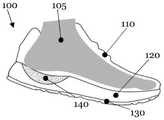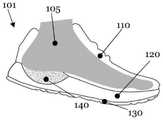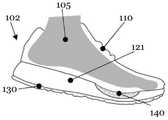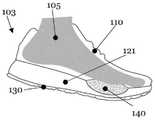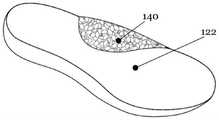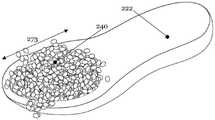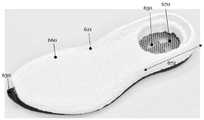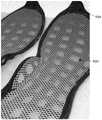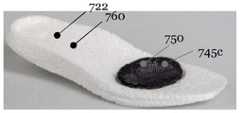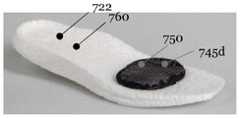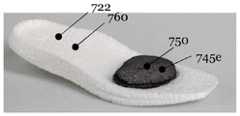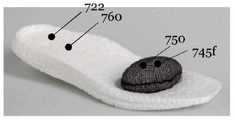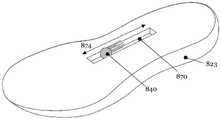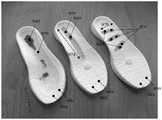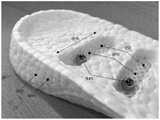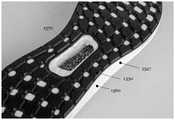CN113133569B - Sole and shoe with tactile feedback - Google Patents
Sole and shoe with tactile feedbackDownload PDFInfo
- Publication number
- CN113133569B CN113133569BCN202011456794.4ACN202011456794ACN113133569BCN 113133569 BCN113133569 BCN 113133569BCN 202011456794 ACN202011456794 ACN 202011456794ACN 113133569 BCN113133569 BCN 113133569B
- Authority
- CN
- China
- Prior art keywords
- sole
- loose particles
- user
- midsole
- shoe
- Prior art date
- Legal status (The legal status is an assumption and is not a legal conclusion. Google has not performed a legal analysis and makes no representation as to the accuracy of the status listed.)
- Active
Links
Images
Classifications
- A—HUMAN NECESSITIES
- A43—FOOTWEAR
- A43B—CHARACTERISTIC FEATURES OF FOOTWEAR; PARTS OF FOOTWEAR
- A43B13/00—Soles; Sole-and-heel integral units
- A43B13/14—Soles; Sole-and-heel integral units characterised by the constructive form
- A—HUMAN NECESSITIES
- A43—FOOTWEAR
- A43B—CHARACTERISTIC FEATURES OF FOOTWEAR; PARTS OF FOOTWEAR
- A43B1/00—Footwear characterised by the material
- A43B1/08—Footwear characterised by the material made of metal
- A—HUMAN NECESSITIES
- A43—FOOTWEAR
- A43B—CHARACTERISTIC FEATURES OF FOOTWEAR; PARTS OF FOOTWEAR
- A43B13/00—Soles; Sole-and-heel integral units
- A43B13/14—Soles; Sole-and-heel integral units characterised by the constructive form
- A43B13/16—Pieced soles
- A—HUMAN NECESSITIES
- A43—FOOTWEAR
- A43B—CHARACTERISTIC FEATURES OF FOOTWEAR; PARTS OF FOOTWEAR
- A43B13/00—Soles; Sole-and-heel integral units
- A43B13/02—Soles; Sole-and-heel integral units characterised by the material
- A43B13/10—Metal
- A—HUMAN NECESSITIES
- A43—FOOTWEAR
- A43B—CHARACTERISTIC FEATURES OF FOOTWEAR; PARTS OF FOOTWEAR
- A43B13/00—Soles; Sole-and-heel integral units
- A43B13/02—Soles; Sole-and-heel integral units characterised by the material
- A43B13/12—Soles with several layers of different materials
- A43B13/125—Soles with several layers of different materials characterised by the midsole or middle layer
- A—HUMAN NECESSITIES
- A43—FOOTWEAR
- A43B—CHARACTERISTIC FEATURES OF FOOTWEAR; PARTS OF FOOTWEAR
- A43B13/00—Soles; Sole-and-heel integral units
- A43B13/14—Soles; Sole-and-heel integral units characterised by the constructive form
- A43B13/18—Resilient soles
- A43B13/181—Resiliency achieved by the structure of the sole
- A—HUMAN NECESSITIES
- A43—FOOTWEAR
- A43B—CHARACTERISTIC FEATURES OF FOOTWEAR; PARTS OF FOOTWEAR
- A43B13/00—Soles; Sole-and-heel integral units
- A43B13/14—Soles; Sole-and-heel integral units characterised by the constructive form
- A43B13/18—Resilient soles
- A43B13/187—Resiliency achieved by the features of the material, e.g. foam, non liquid materials
- A—HUMAN NECESSITIES
- A43—FOOTWEAR
- A43B—CHARACTERISTIC FEATURES OF FOOTWEAR; PARTS OF FOOTWEAR
- A43B13/00—Soles; Sole-and-heel integral units
- A43B13/42—Filling materials located between the insole and outer sole; Stiffening materials
- A—HUMAN NECESSITIES
- A43—FOOTWEAR
- A43B—CHARACTERISTIC FEATURES OF FOOTWEAR; PARTS OF FOOTWEAR
- A43B17/00—Insoles for insertion, e.g. footbeds or inlays, for attachment to the shoe after the upper has been joined
- A43B17/003—Insoles for insertion, e.g. footbeds or inlays, for attachment to the shoe after the upper has been joined characterised by the material
- A—HUMAN NECESSITIES
- A43—FOOTWEAR
- A43B—CHARACTERISTIC FEATURES OF FOOTWEAR; PARTS OF FOOTWEAR
- A43B17/00—Insoles for insertion, e.g. footbeds or inlays, for attachment to the shoe after the upper has been joined
- A43B17/14—Insoles for insertion, e.g. footbeds or inlays, for attachment to the shoe after the upper has been joined made of sponge, rubber, or plastic materials
- A—HUMAN NECESSITIES
- A43—FOOTWEAR
- A43B—CHARACTERISTIC FEATURES OF FOOTWEAR; PARTS OF FOOTWEAR
- A43B5/00—Footwear for sporting purposes
- A43B5/06—Running shoes; Track shoes
- A—HUMAN NECESSITIES
- A43—FOOTWEAR
- A43B—CHARACTERISTIC FEATURES OF FOOTWEAR; PARTS OF FOOTWEAR
- A43B7/00—Footwear with health or hygienic arrangements
- A43B7/14—Footwear with health or hygienic arrangements with foot-supporting parts
- A—HUMAN NECESSITIES
- A43—FOOTWEAR
- A43B—CHARACTERISTIC FEATURES OF FOOTWEAR; PARTS OF FOOTWEAR
- A43B7/00—Footwear with health or hygienic arrangements
- A43B7/14—Footwear with health or hygienic arrangements with foot-supporting parts
- A43B7/1405—Footwear with health or hygienic arrangements with foot-supporting parts with pads or holes on one or more locations, or having an anatomical or curved form
- A43B7/1415—Footwear with health or hygienic arrangements with foot-supporting parts with pads or holes on one or more locations, or having an anatomical or curved form characterised by the location under the foot
- A43B7/1425—Footwear with health or hygienic arrangements with foot-supporting parts with pads or holes on one or more locations, or having an anatomical or curved form characterised by the location under the foot situated under the ball of the foot, i.e. the joint between the first metatarsal and first phalange
- A—HUMAN NECESSITIES
- A43—FOOTWEAR
- A43B—CHARACTERISTIC FEATURES OF FOOTWEAR; PARTS OF FOOTWEAR
- A43B7/00—Footwear with health or hygienic arrangements
- A43B7/14—Footwear with health or hygienic arrangements with foot-supporting parts
- A43B7/1405—Footwear with health or hygienic arrangements with foot-supporting parts with pads or holes on one or more locations, or having an anatomical or curved form
- A43B7/1415—Footwear with health or hygienic arrangements with foot-supporting parts with pads or holes on one or more locations, or having an anatomical or curved form characterised by the location under the foot
- A43B7/144—Footwear with health or hygienic arrangements with foot-supporting parts with pads or holes on one or more locations, or having an anatomical or curved form characterised by the location under the foot situated under the heel, i.e. the calcaneus bone
- A—HUMAN NECESSITIES
- A43—FOOTWEAR
- A43B—CHARACTERISTIC FEATURES OF FOOTWEAR; PARTS OF FOOTWEAR
- A43B7/00—Footwear with health or hygienic arrangements
- A43B7/14—Footwear with health or hygienic arrangements with foot-supporting parts
- A43B7/1405—Footwear with health or hygienic arrangements with foot-supporting parts with pads or holes on one or more locations, or having an anatomical or curved form
- A43B7/1455—Footwear with health or hygienic arrangements with foot-supporting parts with pads or holes on one or more locations, or having an anatomical or curved form with special properties
- A43B7/146—Footwear with health or hygienic arrangements with foot-supporting parts with pads or holes on one or more locations, or having an anatomical or curved form with special properties provided with acupressure points or means for foot massage
- A—HUMAN NECESSITIES
- A43—FOOTWEAR
- A43B—CHARACTERISTIC FEATURES OF FOOTWEAR; PARTS OF FOOTWEAR
- A43B13/00—Soles; Sole-and-heel integral units
- A43B13/02—Soles; Sole-and-heel integral units characterised by the material
- A43B13/04—Plastics, rubber or vulcanised fibre
Landscapes
- Chemical & Material Sciences (AREA)
- Engineering & Computer Science (AREA)
- Materials Engineering (AREA)
- Health & Medical Sciences (AREA)
- General Health & Medical Sciences (AREA)
- Epidemiology (AREA)
- Public Health (AREA)
- Physical Education & Sports Medicine (AREA)
- Life Sciences & Earth Sciences (AREA)
- Wood Science & Technology (AREA)
- Footwear And Its Accessory, Manufacturing Method And Apparatuses (AREA)
Abstract
Translated fromChineseDescription
Translated fromChinese技术领域technical field
本发明涉及一种具有触觉反馈的鞋底和包括该鞋底的鞋The present invention relates to a sole with tactile feedback and a shoe comprising the same
背景技术Background technique
保持健康是当今社会经常希望的愿望。为了实现这个目标,常规的体育活动已经被证明是有效的。最流行的运动之一是跑步。然而,几乎没有考虑跑步或慢跑时候的正确的技术。在比赛水平上,良好的跑步方式可以导致更快的跑步速度和更高的耐力。在业余水平上,改善跑步方式可以有助于降低受伤的风险。然而,即使运动员试图改进其跑步方式,在不使用诸如教练之类的附加人员或诸如视频记录装置之类的昂贵技术设备的情况下,也不容易判断其自身的技术。因此,需要一种装置、工具或运动服装,其适于提供关于跑步技术的可靠反馈。Staying healthy is an often-desired desire in today's society. To achieve this goal, regular physical activity has been shown to be effective. One of the most popular sports is running. However, little consideration is given to proper technique when running or jogging. At the competition level, good running style can lead to faster running speeds and higher endurance. At the amateur level, improving your running style can help reduce the risk of injury. However, even when an athlete tries to improve the way he runs, it is not easy to judge his own technique without the use of additional personnel such as a coach or expensive technical equipment such as video recording devices. Therefore, there is a need for a device, tool or sportswear suitable for providing reliable feedback on running technique.
在鞋类工业中,各种解决方案可用于向使用者提供直接或间接反馈。例如,现有技术文献US 101 36 842 B2公开了一种鞋设备中的传感器,当鞋设备与使用者的脚连接时,该传感器定位成监测使用者的活动技术。当检测到技术较差时,销、球或杆可以适于接触使用者的脚,从而引起不适,并且因此指示技术较差并且激励使用者改进技术。现有技术文献US 2013/0041617 A1涉及用于监测运动表现的系统和方法。一种感测单元,适于附接到使用者的鞋,用于监测脚的运动,例如撞击位置。然后,将所测定的性能特性发送到通知使用者的远程接收机。此外,现有技术文献US 2016/0192862 A1涉及一种基于鞋的分析系统。一种鞋底,泡沫的至少一部分由适于产生电压数据的自感测复合聚合物泡沫代替。电压数据被转换成力数据,与配置文件相比较并且经由用于鞋的穿着者的振动、声音、光图案或视觉显示而反馈给使用者。In the footwear industry, various solutions are available to provide direct or indirect feedback to the user. For example, prior art document US 101 36 842 B2 discloses a sensor in a shoe device positioned to monitor the user's movement technique when the shoe device is connected to the user's foot. When poor technique is detected, the pin, ball or rod may be adapted to contact the user's foot, causing discomfort and thus indicating poor technique and motivating the user to improve technique. The prior art document US 2013/0041617 A1 relates to systems and methods for monitoring athletic performance. A sensing unit adapted to be attached to a user's shoe for monitoring foot movements, such as impact positions. The measured performance characteristics are then sent to a remote receiver that informs the user. Furthermore, the prior art document US 2016/0192862 A1 relates to a shoe-based analysis system. A shoe sole in which at least a portion of the foam is replaced by a self-sensing syntactic polymer foam adapted to generate voltage data. The voltage data is converted to force data, compared to the profile and fed back to the user via vibration, sound, light patterns or visual displays for the wearer of the shoe.
大多数现有技术文献公开了使用电气设备来测定和/或提供关于跑步技术的反馈信息。这种装置通常昂贵、易于出错、需要维护并且增加了使用者的生态足迹。此外,使用硬的、刚性的、位置固定的销的形式的反馈系统可能潜在地为使用者提供烦扰的触觉反馈。在一些情况下,烦扰的触觉反馈可能在使用者为了避免不期望的触觉反馈而调整他们的步态以包括不期望的运动模式时对使用者造成伤害。Most prior art documents disclose the use of electrical devices to measure and/or provide feedback on running technique. Such devices are often expensive, prone to error, require maintenance and increase the user's ecological footprint. Furthermore, the use of a feedback system in the form of a hard, rigid, fixed-position pin may potentially provide annoying tactile feedback to the user. In some cases, disturbing haptic feedback can cause harm to users when they adjust their gait to include undesired movement patterns in order to avoid undesired haptic feedback.
因此,本发明的问题是向使用者提供改进的触觉反馈,使得至少部分地克服现有技术的上述缺点。Therefore, the problem of the present invention is to provide an improved tactile feedback to the user so that the above-mentioned disadvantages of the prior art are at least partially overcome.
发明内容SUMMARY OF THE INVENTION
本发明的独立权利要求的主题至少部分地解决了上述问题。本发明的示例性实施例在从属权利要求中限定。The above-mentioned problems are at least partly solved by the subject-matter of the independent claims of the present invention. Exemplary embodiments of the invention are defined in the dependent claims.
在一个实施例中,本发明提供了一种用于鞋,特别是跑鞋的鞋底,其包括鞋底组件和包含在鞋底组件内的一个或多个松散颗粒。松散颗粒在运动活动期间向鞋底的使用者提供触觉反馈。In one embodiment, the present invention provides a sole for a shoe, particularly a running shoe, comprising a sole assembly and one or more loose particles contained within the sole assembly. The loose particles provide tactile feedback to the user of the sole during athletic activity.
因此,所要求保护的发明提供了一种用于鞋的鞋底,其通过在鞋底组件中使用一个或多个松散颗粒而具有改进的触觉反馈。松散颗粒以简单但有效的方式向包括这种鞋底的鞋的使用者提供特殊的反馈,这允许使用者改进跑步技术。本文中的词语“松散”应当理解为表示不直接附接到周围材料和彼此。因此,所要求保护的发明的一种或多种松散颗粒可以是柔性的,并且能够在鞋底内移动,至少在某种程度上。Accordingly, the claimed invention provides a sole for a shoe with improved haptic feedback through the use of one or more loose particles in the sole assembly. The loose particles provide specific feedback to the user of a shoe comprising such a sole in a simple but effective manner, which allows the user to improve running technique. The word "loose" herein should be understood to mean not directly attached to surrounding materials and to each other. Thus, one or more loose particles of the claimed invention may be flexible and able to move within the sole, at least to some extent.
在本发明的一些实施例中,鞋底组件可以包括中底和/或内底。以这种方式,本发明可以提供由与使用者的脚底几乎直接接触的松散颗粒产生的即时触觉反馈。In some embodiments of the present invention, the sole assembly may include a midsole and/or an insole. In this manner, the present invention can provide immediate tactile feedback from loose particles that are in near direct contact with the sole of the user's foot.
在本发明的一些实施例中,鞋底组件可以包含膨胀材料的颗粒,其可以在它们的表面处熔合。In some embodiments of the present invention, the sole component may contain particles of intumescent material, which may be fused at their surfaces.
膨胀材料的颗粒可以例如包含一种或多种以下材料:膨胀乙烯-乙酸乙烯酯(eEVA)、膨胀热塑性聚氨酯(eTPU)、膨胀聚丙烯(ePP)、膨胀聚酰胺(ePA)、膨胀聚醚嵌段酰胺(ePEBA)、膨胀聚甲醛(ePOM)、膨胀聚苯乙烯(ePS)、膨胀聚乙烯(ePE)、膨胀聚乳酸(ePLA)、膨胀聚对苯二甲酸乙二醇酯(ePET)、膨胀聚对苯二甲酸丁二醇酯(ePBT)和膨胀热塑性烯烃(eTPO)。根据鞋底组件的要求轮廓,这些材料中的一种或多种由于其物质特异的特性而可以有利地用于制造鞋底组件。此外,膨胀颗粒,特别是膨胀TPU,特征在于其良好的弹性和缓冲性能。一方面,膨胀颗粒可以特别地起缓冲作用。因此,例如当鞋撞击地面时产生的外部冲击可以被很好地缓冲,从而实现舒适的穿着舒适性。另一方面,膨胀颗粒可以提供大的弹性。通过大的弹性,为使鞋底变形而吸收的能量在很大程度上再次被鞋底释放。因此,能量的主要部分没有损失。这可以导致对运动员的非常特定的触觉反馈。The particles of expanded material may, for example, comprise one or more of the following materials: expanded ethylene vinyl acetate (eEVA), expanded thermoplastic polyurethane (eTPU), expanded polypropylene (ePP), expanded polyamide (ePA), expanded polyether intercalation Para amide (ePEBA), expanded polyoxymethylene (ePOM), expanded polystyrene (ePS), expanded polyethylene (ePE), expanded polylactic acid (ePLA), expanded polyethylene terephthalate (ePET), expanded Polybutylene terephthalate (ePBT) and expanded thermoplastic olefin (eTPO). Depending on the desired profile of the sole assembly, one or more of these materials may be advantageously used to manufacture the sole assembly due to its substance-specific properties. Furthermore, expanded particles, especially expanded TPU, are characterized by their good elasticity and cushioning properties. On the one hand, the expanded particles can in particular act as a buffer. Therefore, external shocks, such as when the shoe hits the ground, can be well cushioned, thereby achieving comfortable wearing comfort. On the other hand, expanded particles can provide great elasticity. Due to the great elasticity, the energy absorbed for the deformation of the sole is released again by the sole to a large extent. Therefore, the main part of the energy is not lost. This can result in very specific haptic feedback to the athlete.
此外,在同一鞋底组件内提供在其表面处熔合的膨胀材料和一个或多个松散颗粒的混合物可以提供具有不同触觉性质和/或触觉质量的区域,这导致对运动员的甚至更高级的反馈。松散颗粒可以包括与熔合颗粒相同或不同的材料。在脚的辗落(roll-off)运动期间,使用者可以区分不同区域,从而导致根据鞋底组件的具体组成和/或组合而改变触觉反馈感觉。Furthermore, providing a mixture of intumescent material and one or more loose particles fused at its surface within the same sole component can provide regions with different haptic properties and/or haptic qualities, which results in even more advanced feedback to the athlete. The loose particles may comprise the same or a different material than the fused particles. During the roll-off motion of the foot, the user may differentiate between different areas, resulting in varying haptic feedback sensations depending on the specific composition and/or combination of sole components.
在本发明的一些实施例中,鞋底组件的至少一部分可以通过增材制造技术制造。In some embodiments of the present invention, at least a portion of the sole assembly may be manufactured by additive manufacturing techniques.
鞋底组件,特别是中底的增材制造部分,可以例如包括网格结构、脚跟元件、基部或其他。根据一个实施例,鞋底组件的增材制造部分可以由一类材料制造,特别是由聚醚嵌段酰胺(PEBA)或由热塑性聚氨酯(TPU)制造。这可以允许特别有效地制造鞋底组件的所述部分。可替代地,鞋底组件的增材制造部分还可以由聚烯烃制造,例如聚乙烯(PE)、聚苯乙烯(PS)和/或聚丙烯(PP)。原则上,可以使用不同材料(来自不同种类的材料或来自具有稍微不同性质的相同种类的材料)的任意混合物用于增材制造。通过将包括至少增材制造部分和一个或多个松散颗粒的鞋底组件组合在同一鞋底组件内,可提供与上文参照包括膨胀材料的熔合颗粒的鞋底组件所述类似的不同触觉性质和/或触觉质量的区域。The sole component, in particular the additively manufactured part of the midsole, may for example comprise a mesh structure, a heel element, a base or others. According to one embodiment, the additively manufactured part of the sole component may be manufactured from a class of materials, in particular from polyether block amide (PEBA) or from thermoplastic polyurethane (TPU). This may allow the part of the sole assembly to be manufactured particularly efficiently. Alternatively, the additively manufactured part of the sole component may also be manufactured from polyolefins, such as polyethylene (PE), polystyrene (PS) and/or polypropylene (PP). In principle, any mixture of different materials (either from different kinds of materials or from the same kind of materials with slightly different properties) can be used for additive manufacturing. By combining a sole component comprising at least an additively manufactured portion and one or more loose particles within the same sole component, different tactile properties and/or similar to those described above with reference to a sole component comprising fused particles of expanded material may be provided Area of tactile quality.
在一个实施例中,松散颗粒可以至少部分地布置在鞋底组件中的空腔内。为此目的,松散颗粒可以至少部分地嵌入鞋底组件内,同时能够在空腔内自由地到处移动。虽然所有的颗粒可以嵌入在鞋底组件中,但是也包括这样的实施例,其中一定量的颗粒填充到鞋底的空腔中,使得颗粒在周围鞋底材料的表面上方或下方延伸。各种填充量可以用于产生预期的触觉反馈。该反馈可以针对个体或期望的反馈水平(反馈强度)进行优化。例如,关于使用者的跑步技术的反馈可以进一步针对学习该技术的速度而优化,例如,针对专业运动员的强烈反馈以快速地学习到针对刚刚开始跑步的业余运动员的轻/温和反馈的范围。In one embodiment, the loose particles may be disposed at least partially within the cavity in the sole assembly. For this purpose, the loose particles can be embedded at least partially within the sole assembly, while being able to move freely around within the cavity. While all of the particles may be embedded in the sole assembly, embodiments are also included in which an amount of the particles fills the cavity of the sole such that the particles extend above or below the surface of the surrounding sole material. Various fill levels can be used to generate the desired haptic feedback. This feedback can be optimized for the individual or desired feedback level (feedback strength). For example, feedback about the user's running technique can be further optimized for the speed of learning the technique, eg, strong feedback for professional athletes to quickly learn the range of light/moderate feedback for amateur athletes just starting to run.
在一些实施例中,提供触觉反馈可以不涉及任何电子部件。该实施例可特别适用于享受与环境相协调的体育活动,思考他们的生态足迹的运动员。另外,众所周知,诸如电路或电池的电部件受到冲击、撞击、潮湿或类似情况的负面影响或甚至被损坏,这些是运动活动期间鞋的常见外部因素,上述实施例还可以提供一种包括高度耐用和/或不易受故障影响的提供触觉反馈的方式的鞋。此外,电子设备需要电源或内部电池。对电源的需要给使用者造成了维护工作的负担,例如定期充电或更换电池。In some embodiments, providing haptic feedback may not involve any electronic components. This embodiment may be particularly suitable for athletes who enjoy physical activity in harmony with the environment, thinking about their ecological footprint. In addition, it is well known that electrical components such as circuits or batteries are negatively affected or even damaged by shocks, impacts, moisture or the like, which are common external factors to footwear during athletic activities, the above-described embodiments may also provide a product that includes a highly durable and/or shoes that provide haptic feedback in a way that is less susceptible to failure. Additionally, electronic devices require power sources or internal batteries. The need for a power source places a burden on the user for maintenance work, such as regular charging or battery replacement.
在一些实施例中,本发明可提供触觉反馈,包括对使用者脚的发生脚撞击的区域的反馈、对使用者脚的辗落行为的反馈、对使用者步长的反馈、对使用者步频的反馈、对使用者脚的按摩效果或其组合。由于脚底的特征在于其高密度的感觉受体细胞,因此可以针对各种触觉反馈感觉来调整和优化松散颗粒。这种感觉例如可以有助于改善鞋的使用者的跑步技术。附加地或可替代地,这样的感觉还可以例如帮助放松使用者的脚的紧张组织。这样,通过鞋底组件内的松散颗粒的按摩作用,可以在剧烈训练期间和之后提供改善的恢复。接收关于辗落行为的反馈可以例如减少由于长期以不良/非优化技术跑步而导致的伤害。关于步长和/或步频的反馈对于增加跑步的效率或跑步速度可能是特别有益的。这可以导致跑步者的总体表现增强。对使用者脚的发生脚撞击的区域的反馈可以帮助减少脚的特定区域/点上的着地。In some embodiments, the present invention may provide haptic feedback, including feedback on the area of the user's foot where the foot strikes, feedback on the rolling behavior of the user's foot, feedback on the user's stride length, feedback on the user's step Frequent feedback, massage effect on the user's feet, or a combination thereof. Since the sole of the foot is characterized by its high density of sensory receptor cells, the loose particles can be tuned and optimized for various tactile feedback sensations. Such a feeling may, for example, help improve the running technique of the user of the shoe. Additionally or alternatively, such a sensation may also, for example, help to relax tense tissue in the user's foot. In this way, improved recovery can be provided during and after strenuous training through the massaging action of the loose particles within the sole assembly. Receiving feedback on roll-over behavior can, for example, reduce injuries caused by running with poor/non-optimal technique for long periods of time. Feedback on stride length and/or cadence may be particularly beneficial for increasing running efficiency or running speed. This can lead to an increase in the runner's overall performance. Feedback on the area of the user's foot where the foot strikes can help reduce touchdowns on specific areas/points of the foot.
因此,触觉反馈的上述不同场景或其各种组合可以帮助跑步者改进跑步技术、增加跑步效率或跑步速度、帮助恢复、降低受伤的风险和/或还降低由于跑步时不良/非优化的着地和辗落行为而损失的能量的量。Thus, the various scenarios of haptic feedback described above, or various combinations thereof, may help a runner improve running technique, increase running efficiency or running speed, aid in recovery, reduce the risk of injury, and/or also reduce the risk of injury due to poor/non-optimal landing and running while running. The amount of energy lost to a rolling action.
在一个实施例中,松散颗粒可以包括膨胀材料,特别是膨胀热塑性聚氨酯(eTPU)。以上参照在其表面处熔合的膨胀材料描述的其它膨胀材料也可适用于松散膨胀颗粒。松散膨胀材料提供了与熔合膨胀材料相似的良好缓冲和高弹性。如上所述,这些特征在鞋底使用膨胀材料时提供了各种益处。此外,松散膨胀材料的颗粒在它们的运动中是安静的。此外,如果膨胀材料包含TPU,松散eTPU颗粒的表面可以具有一定的粘性/粗糙度,使得颗粒可以主要停留在增加触觉感觉的位置。In one embodiment, the loose particles may comprise expanded materials, particularly expanded thermoplastic polyurethane (eTPU). Other intumescent materials described above with reference to intumescent materials fused at their surfaces may also be suitable for the loose intumescent particles. Loose intumescent materials provide good cushioning and high resiliency similar to fusion intumescent materials. As mentioned above, these features provide various benefits when using intumescent materials for shoe soles. Furthermore, the particles of loosely expanded material are quiet in their motion. Additionally, if the intumescent material contains TPU, the surface of the loose eTPU particles can have a certain tack/roughness so that the particles can primarily stay in locations that increase the tactile sensation.
在本发明的一个实施例中,松散颗粒可以包含金属或硬质材料。众所周知,与用于制造鞋底的标准材料例如塑料或橡胶材料相比,金属具有相对高的比重。还已知的是,松散颗粒能够在所提供的边界内自由移动。通过结合这两个特征并因此在鞋底组件内使用松散的金属颗粒,可以产生鞋的触觉感觉,这可以具体地反馈关于鞋运动的动量变化或方向变化的信息。可以注意到,在同一鞋底组件内的包括膨胀材料的松散颗粒和包括金属或硬质材料的松散颗粒的组合和/或混合物是可能的。In one embodiment of the present invention, the loose particles may comprise metals or hard materials. It is well known that metals have a relatively high specific gravity compared to standard materials used to manufacture shoe soles, such as plastic or rubber materials. It is also known that loose particles are able to move freely within the boundaries provided. By combining these two features and thus using loose metal particles within the sole assembly, a tactile sensation of the shoe can be created, which can specifically feed back information about changes in momentum or direction of shoe movement. It may be noted that combinations and/or mixtures of loose particles comprising intumescent materials and loose particles comprising metals or hard materials within the same sole assembly are possible.
在一个实施例中,松散颗粒的形状可大体为球形或椭球形。球形和椭球形松散颗粒的混合物也是有利的。由于本发明的松散颗粒旨在在运动活动期间向鞋底的使用者提供触觉反馈,因此在使用者的脚和松散颗粒之间可能发生几乎直接的接触。因此,由于防止了尖锐边缘和角部,使用大致球形或椭球形的松散颗粒可防止使用者在跑步时感到不适、疼痛或甚至受伤。此外,由于根据本发明的松散颗粒应当能够在例如鞋底组件的空腔内基本上自由地到处移动,球形或椭球形形状可以改善这种行为,因为一个松散颗粒没有尖锐角部或边缘可能被另一个松散颗粒的角部或边缘捕获。In one embodiment, the loose particles may be generally spherical or ellipsoidal in shape. Mixtures of spherical and ellipsoidal loose particles are also advantageous. Since the loose particles of the present invention are intended to provide tactile feedback to the user of the sole during athletic activity, almost direct contact may occur between the user's foot and the loose particles. Thus, the use of generally spherical or ellipsoidal loose particles can prevent discomfort, pain, or even injury to the user while running, due to the prevention of sharp edges and corners. Furthermore, since loose particles according to the present invention should be able to move around substantially freely within, for example, the cavity of a sole component, a spherical or ellipsoidal shape may improve this behavior, since one loose particle has no sharp corners or edges that could be affected by another A corner or edge capture of a loose particle.
在一个实施例中,松散颗粒可以至少部分地通过设置在鞋底组件的顶侧上的网状材料容纳在鞋底组件内。以这种方式,本发明可以提供松散颗粒与使用者的脚底的几乎直接接触。在一些实施例中,几乎直接的接触可以仅通过网状材料和可选的织物薄层与鞋面分开。众所周知,脚底非常容易通过例如内侧和外侧脚底神经感知和传递大量的刺激到人脑,几乎直接的接触可以提供高度的触觉感觉。因此,即使在脚底上的冲击可能由柔软和/或弹性材料引起,也可以接收触觉反馈。此外,对脚底的冲击可以足够弱。这可以帮助提供触觉反馈,以用于改进和维持良好的跑步技术,而不会由于过度刺激而使其变成负面体验。In one embodiment, loose particles may be contained within the sole assembly, at least in part, by a mesh material disposed on the top side of the sole assembly. In this manner, the present invention can provide for almost direct contact of the loose particles with the sole of the user's foot. In some embodiments, the nearly direct contact may be separated from the upper only by the mesh material and optional fabric sheet. It is well known that the sole of the foot is very easy to sense and transmit a large number of stimuli to the human brain through, for example, the medial and lateral plantar nerves, and almost direct contact can provide a high degree of tactile sensation. Thus, haptic feedback can be received even though the impact on the sole of the foot may be caused by soft and/or elastic materials. Also, the impact to the sole of the foot can be weak enough. This can help provide haptic feedback that can be used to improve and maintain good running technique without turning it into a negative experience due to overstimulation.
在一些实施例中,松散颗粒可以至少部分地由鞋底的外底容纳在中底内,优选地外底包括在面向中底的一侧上的网状材料。取决于期望的触觉反馈或个体运动员,具有中底的完整厚度的体积可以填充有松散颗粒。因此,外底可以至少部分地防止松散颗粒掉出。对于一些运动鞋,高透气性可能是重要的。为此,外底可以包括大于每个松散颗粒的尺寸的开口。在这种情况下,可以在外底和中底之间设置附加的网状材料,以避免颗粒的损失。网状材料的开口通常小于松散颗粒的尺寸。In some embodiments, the loose particles may be contained within the midsole, at least in part, by an outsole of the sole, preferably the outsole comprises a mesh material on the side facing the midsole. Depending on the desired haptic feedback or individual athlete, the volume with the full thickness of the midsole may be filled with loose particles. Thus, the outsole can at least partially prevent loose particles from falling out. For some sneakers, high breathability may be important. To this end, the outsole may include openings larger than the size of each loose particle. In this case, additional mesh material can be placed between the outsole and midsole to avoid particle loss. The openings of the mesh material are generally smaller than the size of the loose particles.
在一些实施例中,松散颗粒可以容纳在由网状材料制成的袋内。为了防止松散颗粒从鞋底组件中掉出,网状袋可能是有益的。网状袋例如可以用于限定松散颗粒可以在其中自由移动的容积。鞋的使用者还可以具有多个具有不同地填充百分比的袋。因此,通过使用不同地填充的袋,不同的触觉感觉是可能的。袋的更换可由使用者或在鞋的销售或服务设施处进行。In some embodiments, the loose particles may be contained within a bag made of mesh material. To prevent loose particles from falling out of the sole assembly, a mesh pocket may be beneficial. A mesh bag, for example, can be used to define a volume in which loose particles can move freely. The user of the shoe may also have multiple pockets with different fill percentages. Thus, by using differently filled bags, different tactile sensations are possible. The replacement of the bag can be done by the user or at a shoe sales or service facility.
在一些实施例中,松散颗粒可以容纳在由箔材料制成的袋内。为了防止水分和/或污垢进入松散颗粒的袋中,完全包封松散颗粒的箔可以是有益的。箔可以足够薄,以不显著减少来自松散颗粒的对使用者的触觉的量。此外,袋可以包括流体。松散颗粒可以悬浮在流体中,以为松散颗粒提供良好的介质,以在运动的同时仍然对运动施加很小的阻力。以这种方式,流体可以适于改善松散颗粒的按摩效果。In some embodiments, the loose particles may be contained within a bag made of foil material. To prevent moisture and/or dirt from entering the bag of loose particles, a foil that completely encapsulates the loose particles may be beneficial. The foil can be thin enough not to significantly reduce the amount of tactile sensation to the user from loose particles. Additionally, the bag may contain fluid. Loose particles can be suspended in a fluid to provide a good medium for the loose particles to move while still applying little resistance to movement. In this way, the fluid can be adapted to improve the massaging effect of the loose particles.
在一些实施例中,与鞋底组件的周围材料相比,松散颗粒可以在使用期间对由使用者的脚施加的压缩力呈现不同的响应。发明人发现,使用者的脚底可以区分鞋底组件的松散颗粒区域和周围材料区域。这可以提供各种各样的不同触觉感觉的可能性,以例如引导运动员以某种方式跑步或帮助运动员恢复。其它触觉反馈场景也是可能的。根据本发明的松散颗粒可以布置在多个分开的区域中、布置在单一区域中或跨越鞋底组件的大部分区域。因此,松散颗粒的可察觉差异可以有助于改进跑步技术的各个方面。松散颗粒还可适于提供对使用者脚的额外支撑。In some embodiments, the loose particles may exhibit a different response to compressive forces applied by a user's foot during use than the surrounding material of the sole assembly. The inventors have discovered that the sole of a user's foot can differentiate between regions of loose particles of a sole assembly and regions of surrounding material. This can provide a wide variety of possibilities for different tactile sensations, to, for example, guide an athlete to run in a certain way or help an athlete recover. Other haptic feedback scenarios are also possible. Loose particles in accordance with the present invention may be arranged in separate regions, in a single region, or across a majority of the sole assembly. Thus, perceptible differences in loose particles can help improve various aspects of running technique. The loose particles may also be adapted to provide additional support for the user's foot.
在一些实施例中,松散颗粒可以布置在鞋的前脚区域中以帮助使用者实现前脚着地跑步(forefoot running strike)。如上所述,对于有抱负的跑步者来说,掌握前脚着地跑步是持续的目标。与以脚跟着地和在整个脚底上辗落的脚跟着地跑步(heel runningstrike)相比,前脚着地跑步描述了以跖球着地和辗落。如果运动员在迈步期间在前脚、中脚或脚跟区域上辗落,则鞋底组件材料的可感知性质改变。当学习前脚着地跑步时,这种效果可能是有用的。因此,在前脚区域中的松散颗粒的布置可以与周围的鞋底组件材料区分开,因此向运动员提供他或她是否如期望地在前脚上着地的直接触觉反馈。In some embodiments, loose particles may be disposed in the forefoot region of the shoe to assist the user in achieving a forefoot running strike. As mentioned above, mastering forefoot running is an ongoing goal for aspiring runners. In contrast to heel runningstrike, which hits the heel and rolls down the entire sole, forefoot running describes a ball landing and a roll-off. If an athlete rolls over the forefoot, midfoot, or heel area during a swing, the perceptible properties of the sole component material change. This effect can be useful when learning to run with the front foot on the ground. Thus, the placement of loose particles in the forefoot region can be distinguished from the surrounding sole assembly material, thus providing the athlete with direct tactile feedback of whether he or she is landing on the forefoot as desired.
在一些实施例中,松散颗粒可以布置在鞋的脚跟区域中以帮助使用者实现前脚着地跑步。如上所述,触觉反馈的基础是松散颗粒和鞋底组件的周围材料之间的可察觉差异。然而,由于可能花费一些时间来学习和习惯前脚着地跑步,尤其是对于刚开始学习该技术的那些人,将松散颗粒布置在脚跟区域中可能是有益的。如已经提到的,与鞋底组件的周围材料相比,松散颗粒可以适于提供增加的缓冲。因此,对于没有经验的前脚撞击者,在该区域中增加的缓冲可以防止受伤,但是仍然可以指示和反馈不期望的脚部着地区域。In some embodiments, loose particles may be disposed in the heel region of the shoe to assist the user in achieving forefoot running. As mentioned above, the basis of haptic feedback is the perceptible difference between the loose particles and the surrounding material of the sole assembly. However, since it may take some time to learn and get used to running on the forefoot, especially for those who are just beginning to learn the technique, it may be beneficial to place loose particles in the heel area. As already mentioned, the loose particles may be adapted to provide increased cushioning compared to the surrounding material of the sole assembly. Thus, for inexperienced forefoot strikers, the added cushioning in this area prevents injury, but still provides indication and feedback of undesired foot landing areas.
在一些实施例中,松散颗粒可以在鞋底的使用期间改变鞋底的有效重量。在本发明中使用的术语“有效重量”应理解为“使用者可感知的重量”,其可以在鞋的运动期间基于例如离心力或松散颗粒的动量的变化而变化。例如,如果松散颗粒可包括实际重量,其可为具有相同尺寸的周围鞋底组件材料的重量的至少两倍,则松散颗粒的动量的变化可向使用者提供实质的触觉反馈。使用者可以感知到松散颗粒的动量的变化,就像外力将施加在鞋的鞋底上一样。因此,鞋底的有效重量可以用作触觉感觉以将关于跑步技术的信息反馈到穿着鞋的运动员。In some embodiments, the loose particles can alter the effective weight of the sole during use of the sole. The term "effective weight" as used in the present invention should be understood as "user-perceivable weight" which may vary during movement of the shoe based on changes in eg centrifugal force or the momentum of loose particles. For example, if the loose particles can include an actual weight, which can be at least twice the weight of the surrounding sole assembly material of the same size, changes in the momentum of the loose particles can provide substantial tactile feedback to the user. The user can perceive the change in the momentum of the loose particles as if an external force would be exerted on the sole of the shoe. Thus, the effective weight of the sole can be used as a tactile sensation to feed back information about running technique to the athlete wearing the shoe.
此外,鞋底的有效重量可至少部分地取决于使用者的步频。如上所述,动量的变化可以由使用者感知为施加到鞋的鞋底的外力。因此,由于高的步频将导致松散颗粒的动量在短时间内多次变化,因此所感知的外力可能更经常地发生并且另外可能感觉更强。因此,在运动活动期间鞋底的有效重量的变化可以为鞋的使用者提供触觉感觉。触觉感觉可以帮助例如增强所使用的跑步技术。Furthermore, the effective weight of the sole may depend, at least in part, on the cadence of the user. As mentioned above, the change in momentum can be perceived by the user as an external force applied to the sole of the shoe. Therefore, the perceived external force may occur more often and may otherwise be felt stronger, since a high cadence will cause the momentum of the loose particles to change multiple times in a short period of time. Thus, changes in the effective weight of the sole during athletic activity may provide a tactile sensation to the user of the shoe. Haptic sensations can help, for example, enhance the running technique used.
在一些实施例中,松散颗粒可以沿着鞋底的纵向方向移动。由于在跑步期间鞋底的纵向方向通常与脚的运动方向一致,基于松散颗粒的有效重量的变化可直接取决于步频。例如,如果在迈步开始时,脚部在身体后面处于其最远距离处并且开始移动到身体前面最远点,则松散颗粒将基于所施加的加速度的方向而被压靠在容纳部的最靠近脚跟区域的部分上。该容纳部可以是空腔、杆、管或类似物。鞋底的有效重量或换句话说松散颗粒的惯性可能已经被使用者感知为触觉感觉。在向前摆动腿之后,在某一点,使用者将开始降低摆动速度以开始着地在地面上。然而,松散颗粒仍可沿向前方向移动,并且因此可冲击容纳部的与前脚区域最接近的部分。该冲击可以被使用者感知为触觉感觉。在跨步的完整周期期间可以感知到附加的感觉。因此,松散颗粒可向使用者反馈多种感觉,这可用于例如通过增加步频、减小步长或其它来增强所应用的跑步技术。In some embodiments, the loose particles can move along the longitudinal direction of the sole. Since the longitudinal direction of the sole typically coincides with the direction of motion of the foot during running, the variation in effective weight based on loose particles can be directly dependent on cadence. For example, if at the start of a swing the foot is at its farthest distance behind the body and begins to move to the farthest point in front of the body, the loose particles will be pressed against the closest point of the receptacle based on the direction of the applied acceleration part of the heel area. The receptacle may be a cavity, rod, tube or the like. The effective weight of the sole or in other words the inertia of the loose particles may already be perceived by the user as a tactile sensation. After swinging the leg forward, at some point, the user will begin to reduce the swing speed to begin landing on the ground. However, loose particles can still move in the forward direction and can therefore impact the portion of the receptacle that is closest to the forefoot region. This shock may be perceived by the user as a tactile sensation. Additional sensations can be perceived during the full cycle of the stride. Thus, the loose particles can feedback a variety of sensations to the user, which can be used to enhance the applied running technique, for example, by increasing stride frequency, decreasing stride length, or otherwise.
在一些实施例中,松散颗粒可以沿着鞋底的内侧至外侧方向移动。如上所述,关于纵向方向,基于惯性和/或松散颗粒对鞋底内的容纳部的冲击的所感知的有效重量和产生的触觉感觉的类似原理对于从内侧至外侧的方向也是有效的。然而,由于与先前实施例相比松散颗粒的移动方向不同,因此所得到的触觉感觉可以反馈不同的信息。例如,如果运动员惯于在跑步时侧向地摇动或摆动脚部,这可能增加受伤的长期风险并且降低跑步表现的效率,能够在鞋底的内侧至外侧方向上移动的松散颗粒可以反馈这种不期望摇动的发生。关于侧向移动的进一步反馈信息也可以应用于本发明。In some embodiments, the loose particles may travel in a medial-to-lateral direction of the sole. As mentioned above, with respect to the longitudinal direction, a similar principle based on the perceived effective weight of inertia and/or the impact of loose particles on the receptacles in the sole and the resulting tactile sensation is also valid for the medial to lateral direction. However, since the loose particles move in a different direction compared to the previous embodiment, the resulting haptic sensation can feed back different information. For example, if an athlete is accustomed to rocking or wiggling the foot sideways while running, which can increase the long-term risk of injury and reduce the efficiency of running performance, loose particles that can move in the medial-to-lateral direction of the sole can feed back this inconvenience. Expect the shaking to happen. Further feedback information on lateral movement can also be applied to the present invention.
可以注意到,纵向方向和内侧至外侧方向还可以包括从所指示的方向向上偏离45°角的方向。因此,根据本发明,松散颗粒的对角移动方向也是适用的。It may be noted that the longitudinal direction and the medial to lateral direction may also include directions that are upwardly offset by an angle of 45° from the direction indicated. Therefore, according to the present invention, the direction of diagonal movement of the loose particles is also applicable.
在另一方面,本发明提供了一种鞋,特别是跑鞋,其包括根据上述实施例之一的鞋底。In another aspect, the present invention provides a shoe, in particular a running shoe, comprising a sole according to one of the above-described embodiments.
附图说明Description of drawings
以下参照附图更详细地描述了本发明的各方面。这些附图示出了:Aspects of the present invention are described in greater detail below with reference to the accompanying drawings. These figures show:
图1a至图1e:包括松散颗粒的鞋和包括松散颗粒的中底的实施例的示意图;FIGS. 1 a to 1 e : schematic diagrams of embodiments of shoes including loose particles and midsoles including loose particles;
图2a至图2c:包括松散颗粒的中底的实施例的示意图;Figures 2a-2c: Schematic diagrams of embodiments of midsole comprising loose particles;
图3a至图3b:包括熔合颗粒和松散颗粒的中底的实施例的示意图;Figures 3a-3b: schematic diagrams of embodiments of midsole including fused particles and loose particles;
图4a至图4c:在顶侧上包括熔合颗粒和网状材料的中底的实施例的示意图;Figures 4a-4c: Schematic diagrams of embodiments of midsole comprising fused particles and mesh material on top side;
图5a至图5c:鞋、外底和中底的实施例的示意图,其中中底包括横跨大部分中底区域的空腔;Figures 5a-5c: schematic diagrams of embodiments of a shoe, outsole, and midsole, wherein the midsole includes a cavity spanning most of the midsole area;
图6a至图6d:鞋、外底和中底的实施例的示意图,其中中底包括在中底的鞋跟区域中的空腔;Figures 6a-6d: schematic diagrams of embodiments of a shoe, outsole, and midsole, wherein the midsole includes a cavity in the heel region of the midsole;
图7a至图7g:中底的实施例的示意图,其中中底包括在前脚区域中的空腔和具有松散颗粒的袋;Figures 7a-7g: Schematic diagrams of embodiments of midsole that include a cavity in the forefoot region and a pocket with loose particles;
图8a至图8c:包括松散金属颗粒的中底的实施例的示意图;Figures 8a-8c: schematic diagrams of embodiments of midsole including loose metal particles;
图9a至图9b:包括熔合颗粒和松散金属颗粒的中底的实施例的示意图;9a-9b: Schematic diagrams of embodiments of midsole including fused particles and loose metal particles;
图10a至图10c:在顶侧上包括熔合颗粒、松散金属颗粒和网状材料的中底的实施例的示意图;Figures 10a-10c: Schematic diagrams of embodiments of midsole comprising fused particles, loose metal particles and mesh material on top side;
图11a至图11b:包括外底和中底的鞋的实施例的示意图,其中中底包括具有松散金属颗粒的空腔;11a-11b : schematic diagrams of embodiments of shoes including an outsole and a midsole, wherein the midsole includes a cavity with loose metal particles;
图12a至图12b:包括空腔的中底和附接到中底的外底的实施例的示意图;Figures 12a-12b: schematic diagrams of embodiments of a midsole including a cavity and an outsole attached to the midsole;
图13a:包括空腔的中底和外底组件的实施例的示意图;Figure 13a: Schematic diagram of an embodiment of a midsole and outsole assembly including a cavity;
图13b至图13c:管的实施例的示意图;Figures 13b to 13c: schematic diagrams of embodiments of tubes;
图14a:包含松散颗粒的流体填充的袋的实施例的示意图;Figure 14a: Schematic diagram of an embodiment of a fluid-filled bag containing loose particles;
图14b:中底的剖面的示意图,其中中底包括悬浮在流体中的松散颗粒;Figure 14b: Schematic diagram of a cross-section of a midsole comprising loose particles suspended in a fluid;
图15:流体填充的袋的实施例的示意图;以及Figure 15: Schematic diagram of an embodiment of a fluid-filled bag; and
图16a至图16c:包括松散颗粒的内底的实施例的示意图。Figures 16a-16c: Schematic representations of embodiments of insoles comprising loose particles.
具体实施方式Detailed ways
下面,参照具有触觉反馈的鞋底和鞋,更详细地描述本发明的示例性实施例。尽管以下相对于本发明的示例性实施例描述了特定的特征组合,但是应当理解,本公开不限于这些实施例。特别地,并非所有特征都必须存在以实现本发明,并且可以通过将一个实施例的某些特征与另一实施例的一个或多个特征相结合来修改实施例。Exemplary embodiments of the present invention are described in more detail below with reference to soles and shoes with haptic feedback. Although specific feature combinations are described below with respect to exemplary embodiments of the invention, it should be understood that the present disclosure is not limited to these embodiments. In particular, not all features are necessarily present in order to practice the invention, and embodiments may be modified by combining certain features of one embodiment with one or more features of another embodiment.
图1a至图1d描绘了以矢状面侧视图示意性地示出穿着根据本发明的鞋100、101、102、103的使用者的脚105的实施例。鞋100、101、102、103包括鞋面110,中底120、121和外底130。中底120、121包括空腔,其填充有各种量的松散颗粒140。松散颗粒140可以包括膨胀材料,特别是膨胀热塑性聚氨酯(eTPU)。在图1a和图1b中,空腔布置在脚105的脚跟区域中,其中图1a展示了松散颗粒140的填充,导致空腔在中底120的周围材料以内的凹形形状。在图1b中,空腔呈现更大的填充量,导致空腔的凸形形状。图1c和图1d示出了类似的情况,其中空腔布置在使用者的脚105的前脚区域。图1c示出了导致凹形形状的填充,图1d示出了导致空腔处的凸形形状的更大量的松散颗粒140填充。松散颗粒140适于向鞋100、101、102、103的使用者提供关于跑步技术的质量的触觉反馈。根据使用者的各种参数,例如技术水平、体重、损伤、脚部缺陷位置等,填充量可以适于在跑步时为运动员提供预期的触觉反馈。Figures 1a to 1d depict an embodiment schematically showing a user's
图1e描绘了本发明的实施例,其示意性地示出了包括在中脚区域中填充有松散颗粒140的空腔的中底122。除了触觉反馈之外,松散颗粒140还可以提供增加的缓冲量,并且能够通过松散颗粒的基本自由的运动来适应脚底的实际形状。因此,本实施例可提供最佳形式的脚弓支撑,其可具体地通过填充量适应个人的需要。根据本发明,也可以适用于其它期望支撑的区域。Figure Ie depicts an embodiment of the present invention, which schematically shows a
图2a至图2c描绘了本发明的实施例,其中松散颗粒240被布置成横跨图2a中的中底220的大部分271,在图2b中的中底221的脚跟区域272中或在图2c中的中底222的前脚区域273中。由于使用者的脚底的特征在于其高密度的感觉受体细胞,因此使用者可以区分松散颗粒240的区域和中底220、221、222的周围材料的区域,周围材料的区域可以包括在其表面处融合的膨胀材料的颗粒,或者可以至少部分地通过增材制造技术制造。这种区分可以基于对在运动活动期间由脚施加到鞋底的各个区域的压缩力或负载的不同响应,从而导致不同的触觉感觉。改变填充有松散颗粒240的空腔的尺寸因此可以导致不同的触觉刺激。如果松散颗粒240的空腔如图2a所示横跨中底220的大部分271,则使用者可体验到一种触觉感觉。如果空腔如图2b或2c所示较小,则使用者可以区分松散颗粒240和周围材料。空腔的尺寸越小,使用者可以越清楚地定位空腔。这可以用于在不需要电子设备(例如电子传感器、远程显示器、摄像系统或其他)的情况下,在跑步的同时仅通过反馈的触觉感觉来引导使用者以特定方式跑步。Figures 2a to 2c depict an embodiment of the present invention in which
如图2b中所描绘的在脚跟区域272中的松散颗粒240的布置可以在跑步时当着地在脚跟上时为使用者提供增加的缓冲。缓冲程度可以通过改变空腔的填充量来单独地调节。此外,由于使用者可基于从鞋底感知的不同触觉反馈来区分在脚跟区域272中或在前脚区域273中的着地,因此本实施例可支持学习期望的跑步技术,诸如前脚着地跑步。The placement of the
由于更高级别的运动员能够使他或她的技术比相对新的运动员更快地适应运动,如图2c中所描绘的松散颗粒240在前脚区域273中的布置可以是有利的。类似于关于图2b所描述的,运动员能够基于每个区域的不同触觉反馈在两个区域272、273中的着地之间进行区分。然而,由于松散颗粒240可以适于提供更高程度的缓冲,将松散颗粒240布置在预期发生脚的大部分着地的区域中可以导致更少的受伤。The placement of
图3a描绘了三个中底320、321、322,其包括在脚跟区域372中、跨越中底320的区域的大部分371、以及在前脚区域373中的空腔370。空腔370包括小于中底320、321、322的厚度的深度。因此,可以省略在中底320、321、322的底侧的用于容纳松散颗粒的附加网状结构或箔。中底320、321、322包括膨胀材料颗粒360,这些颗粒在其表面处熔合在一起。膨胀材料的熔合颗粒340和/或松散颗粒360可以例如包含一种或多种以下材料:膨胀乙烯-乙酸乙烯酯(eEVA)、膨胀热塑性聚氨酯(eTPU)、膨胀聚丙烯(ePP)、膨胀聚酰胺(ePA)、膨胀聚醚嵌段酰胺(ePEBA)、膨胀聚甲醛(ePOM)、膨胀聚苯乙烯(ePS)、膨胀聚乙烯(ePE)、膨胀聚乳酸(ePLA)、膨胀聚对苯二甲酸乙二醇酯(ePET)、膨胀聚对苯二甲酸丁二醇酯(ePBT)和膨胀热塑性烯烃(eTPO)。以这种方式,膨胀材料颗粒可以提供高度的缓冲、热绝缘、重量轻和本领域已知的关于膨胀材料的其它特性,例如关于膨胀TPU的已知特性。FIG. 3a depicts three
图3b描绘了中底320、321的某些部分,其中,空腔示例性地填充有松散颗粒340。松散颗粒340可以包括与颗粒360相同的膨胀材料,颗粒360在其表面处熔合,或者包括一种或多种不同的膨胀材料。尽管本发明的实施例的中底320、321可能仅使用一种材料,但是当将载荷施加到相应的区域上时,基于不同的触觉感觉,使用者的脚可以区分熔合的eTPU 360的区域和松散的eTPU 340的区域。因此,当例如在脚跟区域372上着地并且在鞋的整个鞋底上辗落时,使用者可以定位跨越中底320、321、322的不同区域。根据本发明,这种差异可以用于改善期望的跑步技术或降低跑步时不期望的着地区域的百分比。FIG. 3b depicts portions of the
图4a至图4c描述了三个中底420、421、422,其包括膨胀材料颗粒460,该膨胀材料颗粒460在其表面处熔合。中底420、421、422还包括类似于图3a的空腔470。空腔470分别布置成,在图4a中横跨中底420的大部分471、在图4b中的脚跟区域472中、在图4c中的中底422的前脚区域473中。为了防止松散颗粒在跑步时从空腔470中掉出,网状材料450附接到中底420、421、422的顶侧,顶侧是适于容纳使用者的脚的一侧。网状材料450包括具有小于松散颗粒尺寸的开口的网。此外,网的材料可以包括塑料、金属、橡胶或类似物。在另一实施例中,网状材料450可以是箔。箔可以包括小于松散颗粒尺寸的开口或者可以没有开口。箔还可以是防水的和/或透气的,以增强使用者在运动活动期间的舒适性。网状材料450还可以适于基本上不降低由使用者感知的触觉感觉。因此,网状材料450可以足够薄,使得使用者仍然接收来自松散颗粒的触觉反馈。网状材料450还可以足够软,使得使用者可以区分具有松散颗粒和周围中底材料的区域。Figures 4a to 4c depict three
图5a至图5c描绘了根据本发明的鞋500和包括用于触觉反馈的松散颗粒540的中底520的实施例。松散颗粒540包括膨胀材料,并且布置在中底520的区域的大部分571中。图5a描绘了包括膨胀材料颗粒560的中底520的实施例,膨胀材料颗粒560在其表面处熔合。中底520包括适于填充有松散颗粒540的空腔570。空腔570的深度基本上与中底520的厚度相同。这样,中底520仅在空腔570的侧面提供对松散颗粒540的容纳。因此,为了防止松散颗粒540在穿着鞋500时从中底520掉出,网状材料550从底侧连接到中底520。换句话说,网状材料550布置在鞋500的中底520和外底530之间,如图5b和5c所示。网状材料550可以包括与参照图4的网状材料450所述的类似的特征。网状材料550可以是网或箔。外底530可以包括橡胶、热塑性聚氨酯(TPU)、聚氯乙烯(PVC)或类似的上述材料,其可以适于为鞋500提供高附着摩擦力(traction)和耐用的外底503。外底530包括大于松散颗粒540的尺寸的开口。这样的开口可以为鞋500提供高透气性,在运动活动期间尤其有用。Figures 5a-5c depict an embodiment of a
图5c描绘了鞋500的实施例,其中包括膨胀材料的松散颗粒540布置在中底520的空腔570内。外底530和网状材料550部分地压靠鞋500的其余部分,以指示其优选位置。外底530和网状材料550可以使用粘合剂附接到中底520。在另一实施例中,各种组件可以不使用粘合剂而彼此附接,例如通过施加能量,例如通过加热。作为一个示例,可以应用红外(IR)加热、射频(RF)加热或其它技术来结合包括热塑性材料的各种组件。以这种方式,可以加热包括网状材料550的中底520的底侧和外底530的顶侧,使得至少一个表面可以产生粘合特性,足以将鞋底的各个部分保持在一起。鞋500还可以包括在中底520的顶侧上的第二网状材料(图5a至图5c中未示出),其可以适于容纳使用者的脚。以这种方式,松散颗粒540可以完全容纳在中底520的空腔570以及顶侧和底侧网状材料550内,防止从鞋底掉落,同时仍然为使用者提供松散颗粒540的触觉反馈。FIG. 5c depicts an embodiment of the
图6a至图6d描绘了根据本发明的鞋600和包括用于触觉反馈的松散颗粒640的中底621的另一实施例。图6b和图6c中的外底630和网状材料650的特征与图5a至图5c中的外底530和网状材料550的特征相同。然而,如图6a所示,适于填充有松散颗粒640的中底621的空腔670设置在鞋600的脚跟区域672中,为使用者提供触觉反馈。触觉反馈可以帮助使用者改善他或她的跑步技术,因为在松散颗粒640上的脚跟区域672中的着地可以与没有松散颗粒的前脚区域中的着地区分开。此外,当与中底621的周围材料660相比时,松散颗粒640还可适于提供增强的缓冲。以这种方式,鞋600可以针对偏好在脚跟区域672中着地跑步的运动员进行优化。此外,鞋600可以特别适合于对改善他或她的跑步技术感兴趣的使用者,例如通过学习前脚着地跑步。由于当跑步时从在脚跟区域672中着地过渡到在前脚区域中着地可能花费长达几个月以完全适应使用者的运动系统,脚跟区域672中的松散颗粒640可以有利于缓冲在过渡期间在脚跟区域672中非常可能更频繁的着地。Figures 6a-6d depict another embodiment of a
图7a描绘了根据本发明的包括松散颗粒的中底722的实施例。中底722包括在其表面处熔合的膨胀材料颗粒760和布置在鞋底的前脚区域773中的空腔770。在该实施例中,松散颗粒容纳在包括网状材料750的袋745a至745f内。网状材料750的特征如参照图4a至图4c、图5a至图5c和图6a至图6d的网状材料450、550、650所述。此外,网状材料750可以是可拉伸的,从而松散颗粒可以在袋745a至745f内基本上自由地移动。如图7a至图7g所示,用松散颗粒填充袋745a至745f是可适应的,其中填充可以例如取决于使用者的偏好、期望的触觉刺激、使用者的表现水平和/或使用者的医疗状况。每个袋745a至745f设置成至少部分地位于中底722的空腔770内,从而根据填充情况,前脚区域773的形状范围可以从凹入到凸出中选择。可以使用例如粘合剂、维可牢(Velcro)、适于将袋745a至745f固定在空腔570内的附加顶层、IR加热、RF加热等将袋745a至745f附连至中底722。袋745a至745f可以可更换地附接到中底722。因此,使用者可以在穿着包括中底722的鞋之前例如根据他或她的日常偏好或实际表现水平来选择偏好的袋745a至745f。在另一实施例中,袋745a至745f可仅在专业零售商处或由本领域专家更换。Figure 7a depicts an embodiment of a
图8a至图8c描绘了根据本发明的包括一个或多个松散颗粒840以在运动活动期间向使用者提供触觉反馈的中底823、824、825的进一步的实施例。一个或多个松散颗粒840的重量可以是相同尺寸的周围中底材料的重量的至少两倍。一个或多个松散颗粒840可以包括金属或硬质材料。以这种方式,一个或多个松散颗粒840可以通过使用者的腿的摆动或跨步来激活。一个或多个松散颗粒840的惯性和/或基于松散颗粒840的动量变化而施加到中底823、824、825的力可以被使用者感知为触觉感觉。换句话说,一个或多个松散颗粒840可以在鞋底的使用期间改变鞋底的有效重量,使得使用者可以将有效重量的改变感知为触觉感觉。由于鞋底的有效重量可至少部分地取决于使用者的步频,因此所得到的触觉反馈可以积极的方式影响使用者的步频。Figures 8a-8c depict further embodiments of
图8a描绘了中底823的实施例,其中松散颗粒840可以沿着鞋底的纵向方向874移动。当外力施加到空腔870的前和/或后容纳部时,使用者可以感知到松散颗粒840的加速或减速,其等于动量的变化。一些使用者可以将这种触觉感觉分别报告为鞋底或鞋的有效重量的变化。基于松散颗粒840的移动的纵向方向874(基本上平行于跑步方向),触觉感觉可用于反馈关于使用者的步频的信息。另外,由于步频还至少部分地取决于步幅的长度,因此也可感知到关于步长的触觉反馈。Figure 8a depicts an embodiment of a
图8c描绘了中底825的另一实施例,其中三个松散颗粒840可以沿着鞋底的内侧至外侧方向移动。这里也适用如参照图8a所述的基于松散颗粒840的动量的变化或鞋底的有效重量的变化来感知触觉感觉的基本原理。然而,由于松散颗粒840的运动方向预先确定了可围绕其提供触觉反馈的使用者的脚的运动方向,因此图8c中所示的中底825主要支持确定跑步时脚的侧向876的不期望的摇动或摆动。这种行为可能导致较高的受伤风险和低效的跑步方式。因此,为鞋提供关于跑步时脚的不期望的侧向876移动的触觉反馈可以帮助使用者避免这种行为。因此,包括中底825的鞋可以基于触觉反馈帮助使用者改善他或她的跑步技术。Figure 8c depicts another embodiment of a
图8b描绘了中底824的另一实施例,其中多个松散颗粒840可以在基本上平行于使用者的脚底的二维平面内移动。这里也适用如参照图8a和图8b所述的基于松散颗粒840的动量的变化或鞋底的有效重量的变化来感知触觉感觉的基本原理。然而,由于松散颗粒840适于同时在纵向方向875和内侧至外侧方向877上移动,中底824可同时基于步频和跑步时腿的摆动或摇动来提供触感感觉。此外,由于中底824包括多个松散颗粒840,当与仅具有一个或几个松散颗粒840的实施例相比,所提供的触觉刺激可以被感知为由每个松散颗粒840产生的多个单个触觉刺激模糊成更连续的触觉感觉。Figure 8b depicts another embodiment of a
图9a示出了三个中底923、924、925,其包括一个或多个松散颗粒940,松散颗粒适于在基本上平行于使用者的脚底的二维平面内沿鞋底的纵向方向974和基本上从内侧至外侧的方向976上移动。可以注意到,本发明也可以应用松散颗粒940的其他移动方向。中底923、924、925包括膨胀材料颗粒960,膨胀材料颗粒在其表面处熔合。一个或多个松散颗粒940包括金属或硬质材料。因此,由于一个或多个松散颗粒940包括比中底923、924、925的周围膨胀材料960更高的比重,使用者可以感知到一个或多个松散颗粒940的动量的变化或鞋底的有效重量的变化作为触觉感觉。Figure 9a shows three
图9b描绘了中底925的放大图,其中网状材料951布置在空腔970内和金属松散颗粒940下方以提供金属松散颗粒940的基本上自由的移动。网状材料951还可以布置在各种中底(例如中底923或924)的空腔970中。9b depicts an enlarged view of
图10a至图10c描绘了三个中底1023、1024、1025,其包括一个或多个松散颗粒1040,松散颗粒适于在基本上平行于使用者的脚底的二维平面内、在纵向方向1074上、在鞋底的基本上从内侧至外侧的方向1076上移动。中底1023、1024、1025包括膨胀材料颗粒1060,膨胀材料颗粒在其表面处熔合。为了防止一个或多个松散颗粒1040在跑步时从空腔1070中掉出,网状材料1050附接到中底1023、1024、1025的顶侧,顶侧是适于容纳使用者的脚的一侧。网状材料1050的特性如上文参照图4a至图4c、图5a至图5c、图6a至图6d和图7a至图7g的网状材料450、550、650、750所述。Figures 10a-10c depict three
图11a至图11b描绘了根据本发明的鞋1100和包括松散颗粒1140的中底1126的实施例,该松散颗粒适于在基本上平行于使用者的脚底的二维平面内移动,以提供触觉反馈。松散颗粒1140包括金属或硬质材料,并且布置在中底1126的空腔1170中。空腔1170位于中底1126的底侧上,该底侧是当穿着鞋而静止站立时指向地面的一侧。中底1126包括膨胀材料颗粒1160,膨胀材料颗粒1160在其表面处熔合。由本实施例的金属松散颗粒1140提供的触觉反馈可被使用者感知,而无需与松散颗粒1140直接接触。因此,将松散颗粒1140以小于中底1126厚度的深度定位在空腔1170中可以省略中底1126顶侧上的网状材料1150,防止松散颗粒1140掉出。此外,空腔1170不在中底1126内提供连续开口。因此,中底1126可以是防水的和/或提供热绝缘的。Figures 11a-11b depict an embodiment of a
图11b以仰视图描绘了外底1130和附接至鞋1100的网状材料1150。外底1130和网状材料1150的特征分别如上文关于图5和图6的外底530和630以及图4a至图4c、图5a至图5c、图6a至图6d、图7a至图7g和图10a至图10c的网状材料450、550、650、750、1050所讨论的。FIG. 11b depicts the
图12a描绘了包括膨胀材料颗粒1260的中底1227的实施例,膨胀材料颗粒1260在其表面处熔合。根据本发明,中底1227进一步包括适于容纳一个或多个松散颗粒的空腔1270,以提供触觉反馈。空腔1270沿鞋底的纵向方向1274布置,因此预定义了一个或多个松散颗粒的移动方向。一个或多个松散颗粒可以包括金属。以这种方式,一个或多个松散颗粒的纵向移动可以导致触觉感觉,从而积极地影响例如使用者的步频。图12a的一个或多个松散颗粒布置在由网状材料1250形成的管1280内。网状材料1250的特性如以上参照图4a至图4c、图5a至图5c、图6a至图6d、图7a至图7g、图10a至图10c和图11a至图11b的网状材料450、550、650、750、1050、1150所讨论。由于网状材料1250的管1280防止了一个或多个松散颗粒掉出,所以可以省略中底1227和外底1230之间的网状材料1250的附加层,如图12b所示。在本实施例中,包括一种或多种松散颗粒的管1280不是可改变的,以确保空腔1270没有不期望的运动。因此,空腔1270可以由外底1230覆盖。Figure 12a depicts an embodiment of a
在图13a所示的类似实施例中,一个或多个松散颗粒可以布置在包括塑料、橡胶、PVC、TPU或类似材料的管或杆1380内,如图13b和图13c所示。管或杆1380可适于在中底1327的空腔1370内可更换,其中中底1327包括在其表面处熔合的膨胀材料1360的颗粒。因此,鞋的使用者可以根据他或她期望的触觉刺激来调整管或杆1380内的松散颗粒。如果使用者例如更喜欢更强烈和/或直接的触觉反馈,则比之前所使用的具有更高重量的一个或多个松散金属颗粒可能是合适的。相反,如果使用者更喜欢例如更微妙和/或更不强烈的触觉反馈,则比之前所使用的具有较轻重量的一个或多个松散金属颗粒可能是有益的。管或杆1380可以包括两个帽(未示出),这两个帽可以打开1385以用于更换一个或多个松散颗粒,如图13b中所描绘的。在一个替代性实施例中,管或杆1380可以是永久密封1386的。这样,使用者可以在包括不同特性的各种管或杆1380之间进行选择,这些特性例如松散颗粒的重量或数量、管或杆1380的尺寸或类似特性。此外,管或杆1380的长度可以是可调节的(未示出)。以这种方式,由于触觉感觉取决于管或杆1380的长度,所提供的触觉刺激可以是可适应的。例如,可以调节管或杆1380的长度以产生触觉反馈,从而积极地影响使用者以期望的步频跑步。此外,管或杆1380的长度可以适于使用者的身体尺寸,例如高度、偏好的步长或类似。In a similar embodiment as shown in Figure 13a, one or more loose particles may be disposed within a tube or
可以注意到,可更换管或杆1380也可以应用在沿内侧至外侧方向或任何其它方向布置的空腔中。此外,包括沿纵向方向布置的空腔和沿内侧至外侧方向布置的空腔的实施例也是可能的。以这种方式,使用者可以决定对于哪个运动需要触觉反馈,并且相应地将包括松散颗粒的管或杆1380附接到相应的空腔1370。使用者还可以同时附接两个管或杆1380,每个管或杆布置在空腔1370中的一个中,用于同时接收两个运动方向的触觉反馈。中底的空腔和管的数量可以不限于上述示例。It may be noted that the replaceable tube or
图14a描述了根据本发明的包括松散颗粒1440的流体填充袋1445的实施例。松散颗粒1440容纳在袋1445内并且可悬浮在流体1447中。作为上文参照图1a到图13c所描述的松散颗粒140、240、340、540、640、840、940、1040、1140所论述的触觉反馈的替代或补充,松散颗粒1440可进一步适于为使用者的脚提供具有舒适按摩效果形式的触觉反馈。根据按摩所需的强度,松散颗粒1440可以包括各种硬度、材料和/或尺寸,其可以适用于使用者脚的不同区域。此外,流体1447可包括凝胶、液体或油。流体1447可适于为松散颗粒1440提供介质,以在提供一定程度的阻力的同时基本上自由地移动。通过选择某种流体、凝胶、液体或油,阻力的程度可以适于提供按摩效果的期望强度。在另一实施例中,可使用气体,尤其是空气,来代替流体1447。松散颗粒1440可以适于随着每步在袋1445内重新分布,从而导致施加到使用者脚的肌肉和其它组织的不断变化的压力点。松散颗粒1440在每步中的重新分布可以最接近地模拟主动的人体按摩。袋1445的各个区域,基于接触该区域的脚部的解剖学结构而特别优化,可以被分成前脚区域1446a、中脚区域1446b和后脚区域1446c,如图14a所示。其它分割或更多/更少的分离区域也是可能的。为了提供松散颗粒与使用者脚底的基本直接接触,袋1445或不同的容纳区域可以设置在中底1428的顶部,如图14b所示。中底1428可以由任选的软内底层1411或鞋的鞋面的软底部分覆盖。中底1428还可以包括摇杆(rocker)几何形状,即,朝向鞋垫(foot bed)的中心倾斜的中底的略微弯曲的形状。松散颗粒1440的按摩效果可以由中底1428的摇杆几何形状的圆形形状而加强,从而有助于在每一步中将松散颗粒1440按压到使用者的组织中。此外,摇杆几何结构可以进一步使得使用者能够在就座时前后辗动(roll)他/她的脚,这可以通过刺激例如下背部肌肉来帮助改善这种鞋的使用者的姿势。Figure 14a depicts an embodiment of a fluid-filled
图15描绘了包括如参照图14a类似地描述的三个分开的区域1546a至1546c的流体填充的袋1545的实施例。根据本发明,每个分开的区域1546a至1546c可以填充松散颗粒以提供按摩效果(图15中未示出)。松散颗粒可以悬浮在流体1547或气体1548中。而且,流体1547和气体1548的混合物是可能的,例如部分地填充有流体1547的袋1545的区域1546a至1546c。袋1545例如可以包括两层TPU,通过使用粘合剂或类似技术经由诸如IR或RF加热的热结合彼此附接。允许薄的、软层的和密封的袋1545的各种其它材料也是适用的。Figure 15 depicts an embodiment of a fluid-filled
图16a至16b以俯视图示出了根据本发明的包括松散颗粒1640a至1629b的内底1629a至1629b的实施例。图16c以后视图描绘了内底1629。松散颗粒1640a至1640b可被容纳在袋中,其特征如参照图14a和15的袋1445和1545所讨论的。松散颗粒1640a可包括非膨胀材料,特别是直径为1mm至5mm、优选2mm至4mm的小球形式的TPU、EVA、PET、PBT或橡胶,如图16a所示。可替代地,松散颗粒1640b可包括如图16b中所示的膨胀材料,特别是以上参照图3a至图3b的融合颗粒340或松散颗粒360列出的膨胀材料中的一种或多种。松散颗粒1640b的尺寸可类似于松散颗粒1640a的尺寸。基于按摩效果的期望强度,可以为内底1629a的各个区域1646a至1646c选择较软的膨胀松散颗粒1640b或较硬的非膨胀松散颗粒1640a。膨胀松散颗粒1640b和非膨胀松散颗粒1640a的混合物也是可能的。此外,按摩效果的强度还可以通过用以下一种或多种物质填充袋的程度来调节:非膨胀或膨胀松散颗粒、流体或气体。袋可以进一步封装到软材料1648中,例如EVA、TPU、PET、PBT或橡胶。以这种方式,在本发明的一些实施例中,内底1629a至1629b可以直接附接到鞋的中底(未示出)。作为内底1629a、1629b的替代,松散颗粒16140a至16140b可以类似地布置在鞋的中底1428内,特别是鞋的中底1428的顶部区段内,如图14b中所描绘的。在另一替代性实施例中,松散颗粒1640a至1640b可设置在单独的内底1629a至1629b内,例如鞋垫(sockliner),其适于可插入到使用者已经拥有的相应尺寸的任何鞋中。以这种方式,具有包括松散颗粒1640a至1640b的区域1646a至1646c的不同数量或布置的各种内底1629a至1629b可以被更换地提供。Figures 16a-16b illustrate, in top view, embodiments of
可以注意到,上述与布置在中底120、121、122、220、221、222、320、321、322、420、421、422、520、621、722、1428中的松散颗粒140、240、340、540、640、1440相关的用于提供触觉反馈的特征可以类似地布置在根据本发明的内底1629a至1629b内,反之亦然。It can be noted that the above and
下面,描述了进一步的实施例以便于理解本发明:Below, further embodiments are described to facilitate understanding of the present invention:
1.一种用于鞋(100、101、102、103、500、600、1100)的鞋底,所述鞋特别是跑鞋,所述鞋底包括:1. A sole for shoes (100, 101, 102, 103, 500, 600, 1100), in particular running shoes, comprising:
a.鞋底组件;以及a. sole components; and
b.容纳在鞋底组件内的一个或多个松散颗粒(140、240、340、540、640、840、940、1040、1140、1440、1640a、1640b),b. one or more loose particles (140, 240, 340, 540, 640, 840, 940, 1040, 1140, 1440, 1640a, 1640b) contained within the sole assembly,
c.其中,松散颗粒在运动活动期间向鞋底的使用者提供触觉反馈。c. wherein the loose particles provide tactile feedback to the user of the sole during athletic activity.
2.根据实施例1的鞋底,其中,鞋底组件包括中底(120、121、122、220、221、222、320、321、322、420、421、422、520、621、722、823、824、825、923、924、925、1023、1024、1025、1126、1227、1327、1428)和/或内底(1629a、1629b)。2. The sole according to embodiment 1, wherein the sole assembly comprises a midsole (120, 121, 122, 220, 221, 222, 320, 321, 322, 420, 421, 422, 520, 621, 722, 823, 824 , 825, 923, 924, 925, 1023, 1024, 1025, 1126, 1227, 1327, 1428) and/or insole (1629a, 1629b).
3.根据实施例1或2的鞋底,其中,鞋底组件包括膨胀材料颗粒(360、460、560、660、760、960、1060、1160、1260、1360),特别是膨胀热塑性聚氨酯eTPU的颗粒,所述颗粒在其表面处熔合。3. The sole according to embodiment 1 or 2, wherein the sole component comprises particles of expanded material (360, 460, 560, 660, 760, 960, 1060, 1160, 1260, 1360), in particular of expanded thermoplastic polyurethane eTPU, The particles are fused at their surfaces.
4.根据实施例1至3中任一项的鞋底,其中,鞋底组件的至少一部分通过增材制造技术制造。4. The sole of any of embodiments 1 to 3, wherein at least a portion of the sole component is manufactured by additive manufacturing techniques.
5.根据实施例1至4中任一项的鞋底,其中,松散颗粒至少部分地布置在鞋底组件中的空腔(370、470、570、670、770、870、970、1070、1170、1270、1370)内。5. The sole of any one of embodiments 1 to 4, wherein the loose particles are at least partially disposed within the cavities (370, 470, 570, 670, 770, 870, 970, 1070, 1170, 1270) in the sole assembly , 1370).
6.根据实施例1至5中任一项的鞋底,其中,提供触觉反馈不涉及任何电子部件。6. The sole of any of embodiments 1 to 5, wherein no electronic components are involved in providing the haptic feedback.
7.根据实施例1至6中任一项的鞋底,其中,触觉反馈包括对使用者脚的发生脚撞击的区域的反馈、对使用者脚的辗落行为的反馈、对使用者步长的反馈、对使用者步频的反馈、对使用者脚的按摩效果、或其组合。7. The sole of any one of embodiments 1 to 6, wherein the tactile feedback includes feedback on the area of the user's foot where the foot strikes, feedback on the roll-off behavior of the user's foot, feedback on the user's stride length. Feedback, feedback on the user's cadence, massage effect on the user's feet, or a combination thereof.
8.根据实施例1至7中任一项的鞋底,其中,松散颗粒包括膨胀材料,特别是膨胀热塑性聚氨酯eTPU。8. The sole according to any one of embodiments 1 to 7, wherein the loose particles comprise an expanded material, in particular expanded thermoplastic polyurethane eTPU.
9.根据实施例1至7中任一项的鞋底,其中,松散颗粒包括金属。9. The sole of any of embodiments 1 to 7, wherein the loose particles comprise metal.
10.根据实施例1至9中任一项的鞋底,其中,松散颗粒的形状是大致球形或椭球形。10. The sole of any one of embodiments 1 to 9, wherein the shape of the loose particles is substantially spherical or ellipsoidal.
11.根据实施例1至10中任一项的鞋底,其中,松散颗粒至少部分地通过设置在鞋底组件的顶侧上的网状材料(450、1050)而容纳在鞋底组件内。11. The sole of any one of embodiments 1 to 10, wherein the loose particles are contained within the sole assembly at least partially by a mesh material (450, 1050) disposed on the top side of the sole assembly.
12.根据实施例2至11中任一项的鞋底,其中,松散颗粒至少部分地通过鞋底的外底(530、630、1130、1230、1330)而容纳在中底内,优选地,外底在面向中底的一侧上包括网状材料(550、650、1150)。12. The sole according to any one of embodiments 2 to 11, wherein the loose particles are contained within the midsole, preferably the outsole, at least partially through the outsole (530, 630, 1130, 1230, 1330) of the sole Mesh material (550, 650, 1150) is included on the side facing the midsole.
13.根据实施例1至8和10至12中任一项的鞋底,其中,松散颗粒容纳在由网状材料(750)制成的袋(745a至745f)内。13. The sole according to any one of embodiments 1 to 8 and 10 to 12, wherein the loose particles are contained within pockets (745a to 745f) made of mesh material (750).
14.根据实施例1至8和10至12中任一项的鞋底,其中,松散颗粒容纳在由箔材料制成的袋(1445、1545)内。14. The sole according to any of embodiments 1 to 8 and 10 to 12, wherein the loose particles are contained within a bag (1445, 1545) made of foil material.
15.根据实施例14的鞋底,其中,袋包括流体(1447、1547)。15. The sole of embodiment 14, wherein the pocket comprises a fluid (1447, 1547).
16.根据实施例1至8和10至15中任一项的鞋底,其中,与鞋底组件的周围材料相比,松散颗粒在使用期间对由使用者的脚施加的压缩力呈现不同的响应。16. The sole of any of embodiments 1 to 8 and 10 to 15, wherein the loose particles exhibit a different response to compressive forces applied by a user's foot during use than the surrounding material of the sole assembly.
17.根据实施例1至8和10至16中任一项的鞋底,其中,松散颗粒布置在鞋的前脚区域(273、373、473、773)中,以帮助使用者实现前脚着地跑步。17. The sole of any of embodiments 1 to 8 and 10 to 16, wherein loose particles are disposed in the forefoot region (273, 373, 473, 773) of the shoe to assist the user in achieving forefoot running.
18.根据实施例1至8和10至17中任一项的鞋底,其中,松散颗粒布置在鞋的脚跟区域(272、372、472、672)中,以帮助使用者实现前脚着地跑步。18. The sole of any of embodiments 1 to 8 and 10 to 17, wherein loose particles are disposed in the heel region (272, 372, 472, 672) of the shoe to assist the user in achieving forefoot running.
19.根据实施例1至7和9至12中任一项的鞋底,其中,松散颗粒在鞋底的使用期间改变鞋底的有效重量。19. The sole of any one of embodiments 1 to 7 and 9 to 12, wherein the loose particles change the effective weight of the sole during use of the sole.
20.根据实施例19的鞋底,其中,鞋底的有效重量至少部分地取决于使用者的步频。20. The sole of embodiment 19, wherein the effective weight of the sole depends at least in part on the cadence of the user.
21.根据实施例1至7、9至12、19和20中任一项的鞋底,其中,松散颗粒能够沿着鞋底的纵向方向(874、875、974、1074、1274)移动。21. The sole according to any one of embodiments 1 to 7, 9 to 12, 19 and 20, wherein the loose particles are movable along the longitudinal direction of the sole (874, 875, 974, 1074, 1274).
22.根据实施例1至7、9至12和19至21中任一项的鞋底,其中,松散颗粒能够沿着鞋底的内侧至外侧方向(876、877、976、1076)移动。22. The sole of any one of embodiments 1 to 7, 9 to 12, and 19 to 21, wherein the loose particles are movable along a medial to lateral direction (876, 877, 976, 1076) of the sole.
23.一种鞋(100、101、102、103、500、600、1100),特别是跑鞋,包括根据前述实施例中任一项的鞋底。23. A shoe (100, 101, 102, 103, 500, 600, 1100), in particular a running shoe, comprising a sole according to any of the preceding embodiments.
Claims (16)
Translated fromChinesePriority Applications (1)
| Application Number | Priority Date | Filing Date | Title |
|---|---|---|---|
| CN202211135907.XACN115644559A (en) | 2020-01-17 | 2020-12-10 | Soles and shoes with haptic feedback |
Applications Claiming Priority (2)
| Application Number | Priority Date | Filing Date | Title |
|---|---|---|---|
| DE102020200558.3 | 2020-01-17 | ||
| DE102020200558.3ADE102020200558B4 (en) | 2020-01-17 | 2020-01-17 | Sole and shoe with haptic feedback |
Related Child Applications (1)
| Application Number | Title | Priority Date | Filing Date |
|---|---|---|---|
| CN202211135907.XADivisionCN115644559A (en) | 2020-01-17 | 2020-12-10 | Soles and shoes with haptic feedback |
Publications (2)
| Publication Number | Publication Date |
|---|---|
| CN113133569A CN113133569A (en) | 2021-07-20 |
| CN113133569Btrue CN113133569B (en) | 2022-10-14 |
Family
ID=73838905
Family Applications (2)
| Application Number | Title | Priority Date | Filing Date |
|---|---|---|---|
| CN202011456794.4AActiveCN113133569B (en) | 2020-01-17 | 2020-12-10 | Sole and shoe with tactile feedback |
| CN202211135907.XAPendingCN115644559A (en) | 2020-01-17 | 2020-12-10 | Soles and shoes with haptic feedback |
Family Applications After (1)
| Application Number | Title | Priority Date | Filing Date |
|---|---|---|---|
| CN202211135907.XAPendingCN115644559A (en) | 2020-01-17 | 2020-12-10 | Soles and shoes with haptic feedback |
Country Status (4)
| Country | Link |
|---|---|
| US (2) | US12178280B2 (en) |
| EP (2) | EP4494512A3 (en) |
| CN (2) | CN113133569B (en) |
| DE (1) | DE102020200558B4 (en) |
Families Citing this family (19)
| Publication number | Priority date | Publication date | Assignee | Title |
|---|---|---|---|---|
| DE102012206094B4 (en) | 2012-04-13 | 2019-12-05 | Adidas Ag | Soles for sports footwear, shoes and method of making a shoe sole |
| DE102013202306B4 (en) | 2013-02-13 | 2014-12-18 | Adidas Ag | Sole for a shoe |
| DE102013202291B4 (en) | 2013-02-13 | 2020-06-18 | Adidas Ag | Damping element for sportswear and shoes with such a damping element |
| US9930928B2 (en) | 2013-02-13 | 2018-04-03 | Adidas Ag | Sole for a shoe |
| USD776410S1 (en)* | 2013-04-12 | 2017-01-17 | Adidas Ag | Shoe |
| DE102015202013B4 (en) | 2015-02-05 | 2019-05-09 | Adidas Ag | Process for producing a plastic molding, plastic molding and shoe |
| DE102016209046B4 (en) | 2016-05-24 | 2019-08-08 | Adidas Ag | METHOD FOR THE PRODUCTION OF A SHOE SOLE, SHOE SOLE, SHOE AND PREPARED TPU ITEMS |
| DE102016223567A1 (en) | 2016-11-28 | 2018-05-30 | Adidas Ag | Process for the production of sporting goods and sporting goods |
| DE102016223980B4 (en) | 2016-12-01 | 2022-09-22 | Adidas Ag | Process for the production of a plastic molding |
| USD928479S1 (en)* | 2019-03-19 | 2021-08-24 | Adidas Ag | Footwear midsole |
| USD938154S1 (en)* | 2019-07-18 | 2021-12-14 | Adidas Ag | Footwear sole |
| US11766092B2 (en)* | 2020-02-21 | 2023-09-26 | Nike, Inc. | Sole structure for article of footwear |
| US20220225731A1 (en)* | 2020-08-03 | 2022-07-21 | Hafia Salum Mkumba | Footwear midsole comprising a support and one or more internal bladders |
| US20230011794A1 (en)* | 2021-07-12 | 2023-01-12 | Invonu Llc | Controlled friction interfacing |
| USD1093824S1 (en) | 2021-07-13 | 2025-09-23 | Adidas Ag | Shoe midsole |
| FR3125206B1 (en)* | 2021-07-16 | 2024-09-20 | Decathlon Sa | Sole element, footwear article comprising such a sole element, and methods of manufacturing such a sole element and such a footwear article. |
| USD1096103S1 (en)* | 2023-04-03 | 2025-10-07 | Ecco Sko A/S | Footwear |
| US12369689B2 (en)* | 2023-04-26 | 2025-07-29 | Zining Wang | Smart insole special for golf |
| WO2025163613A1 (en)* | 2024-02-03 | 2025-08-07 | Green David Harold | Foot comforting device, and a footwear comprising the same |
Citations (4)
| Publication number | Priority date | Publication date | Assignee | Title |
|---|---|---|---|---|
| US5564202A (en)* | 1990-05-24 | 1996-10-15 | Hoppenstein; Reuben | Hydropneumatic support system for footwear |
| CN108289529A (en)* | 2015-09-24 | 2018-07-17 | 耐克创新有限合伙公司 | The valve jacket that particle foam stacks |
| CN108366644A (en)* | 2015-12-07 | 2018-08-03 | 彪马欧洲股份公司 | Shoes, especially sport footwear |
| WO2020011843A1 (en)* | 2018-07-10 | 2020-01-16 | Jacek Czernicki | Device for stride variation |
Family Cites Families (25)
| Publication number | Priority date | Publication date | Assignee | Title |
|---|---|---|---|---|
| US1841461A (en)* | 1927-04-13 | 1932-01-19 | North American Chemical Compan | Shoe bottom filler sheet or piece |
| US3971839A (en)* | 1971-12-06 | 1976-07-27 | Taylor Don A | Particle filled self-conformable cushion and method of making same |
| US4658515A (en)* | 1985-02-05 | 1987-04-21 | Oatman Donald S | Heat insulating insert for footwear |
| DE3802607A1 (en)* | 1987-12-17 | 1989-06-29 | Adidas Sportschuhe | OUTSOLE FOR SPORTSHOES |
| US6782640B2 (en)* | 2001-09-12 | 2004-08-31 | Craig D. Westin | Custom conformable device |
| US7484318B2 (en)* | 2004-06-15 | 2009-02-03 | Kenneth Cole Productions (Lic), Inc. | Therapeutic shoe sole design, method for manufacturing the same, and products constructed therefrom |
| US20060026863A1 (en)* | 2004-08-05 | 2006-02-09 | Dong-Long Liu | Shoe shole and method for making the same |
| US20060130363A1 (en) | 2004-12-17 | 2006-06-22 | Michael Hottinger | Shoe sole with a loose fill comfort support system |
| ATE482991T1 (en)* | 2006-01-18 | 2010-10-15 | Basf Se | FOAM BASED ON THERMOPLASTIC POLYURETHANES |
| US20110099845A1 (en)* | 2009-11-03 | 2011-05-05 | Miller Michael J | Customized footwear and methods for manufacturing |
| CN102196322B (en) | 2010-03-12 | 2015-06-10 | 中兴通讯股份有限公司 | Optical power regulation method of Ethernet passive optical network (EPON) and optical line terminal |
| JP2014504943A (en) | 2011-02-07 | 2014-02-27 | ニュー バランス アスレティック シュー,インコーポレーテッド | System and method for monitoring athletic performance |
| US9078493B2 (en)* | 2011-12-09 | 2015-07-14 | Body Fort, LLC | Footwear assembly |
| US20150313313A1 (en) | 2011-12-09 | 2015-11-05 | Body Fort, LLC | Footwear assembly |
| EP2882788B1 (en)* | 2012-08-09 | 2016-10-12 | Basf Se | Combination foam |
| US9930928B2 (en)* | 2013-02-13 | 2018-04-03 | Adidas Ag | Sole for a shoe |
| CN104068558B (en)* | 2013-03-29 | 2016-09-28 | 黄英俊 | A sole structure for adjusting sole weight |
| US9713357B2 (en)* | 2014-07-15 | 2017-07-25 | Taylor Made Golf Company, Inc. | Asymmetric shoes |
| US10136842B2 (en) | 2014-11-26 | 2018-11-27 | Icon Health & Fitness, Inc. | Footwear apparatus with technique feedback |
| US10405779B2 (en) | 2015-01-07 | 2019-09-10 | Nano Composite Products, Inc. | Shoe-based analysis system |
| US10448699B2 (en) | 2015-11-09 | 2019-10-22 | Nike, Inc. | Article of footwear with a tactile feedback system |
| DE102016209046B4 (en)* | 2016-05-24 | 2019-08-08 | Adidas Ag | METHOD FOR THE PRODUCTION OF A SHOE SOLE, SHOE SOLE, SHOE AND PREPARED TPU ITEMS |
| WO2019207569A1 (en)* | 2018-04-22 | 2019-10-31 | Insand Ltd. | Insole, insert, sole, and shoes and footwear having such components |
| US11330863B2 (en)* | 2018-05-14 | 2022-05-17 | Twisted X, Inc. | Cushioning for shoe sole |
| EP4009827B1 (en)* | 2019-07-25 | 2023-09-27 | NIKE Innovate C.V. | Article of footwear |
- 2020
- 2020-01-17DEDE102020200558.3Apatent/DE102020200558B4/enactiveActive
- 2020-12-10CNCN202011456794.4Apatent/CN113133569B/enactiveActive
- 2020-12-10CNCN202211135907.XApatent/CN115644559A/enactivePending
- 2020-12-15EPEP24203783.6Apatent/EP4494512A3/enactivePending
- 2020-12-15EPEP20213991.1Apatent/EP3850976B1/enactiveActive
- 2020-12-15USUS17/122,911patent/US12178280B2/enactiveActive
- 2024
- 2024-11-14USUS18/947,634patent/US20250064168A1/enactivePending
Patent Citations (4)
| Publication number | Priority date | Publication date | Assignee | Title |
|---|---|---|---|---|
| US5564202A (en)* | 1990-05-24 | 1996-10-15 | Hoppenstein; Reuben | Hydropneumatic support system for footwear |
| CN108289529A (en)* | 2015-09-24 | 2018-07-17 | 耐克创新有限合伙公司 | The valve jacket that particle foam stacks |
| CN108366644A (en)* | 2015-12-07 | 2018-08-03 | 彪马欧洲股份公司 | Shoes, especially sport footwear |
| WO2020011843A1 (en)* | 2018-07-10 | 2020-01-16 | Jacek Czernicki | Device for stride variation |
Also Published As
| Publication number | Publication date |
|---|---|
| CN113133569A (en) | 2021-07-20 |
| US20250064168A1 (en) | 2025-02-27 |
| EP3850976B1 (en) | 2024-10-02 |
| DE102020200558B4 (en) | 2025-08-21 |
| DE102020200558A1 (en) | 2021-07-22 |
| EP4494512A3 (en) | 2025-01-29 |
| EP4494512A2 (en) | 2025-01-22 |
| US20210219655A1 (en) | 2021-07-22 |
| CN115644559A (en) | 2023-01-31 |
| EP3850976A1 (en) | 2021-07-21 |
| US12178280B2 (en) | 2024-12-31 |
Similar Documents
| Publication | Publication Date | Title |
|---|---|---|
| CN113133569B (en) | Sole and shoe with tactile feedback | |
| US12102172B2 (en) | Footwear midsole with warped lattice structure and method of making the same | |
| CN114343290B (en) | Footwear midsole with anisotropic mesh and method of making the same | |
| EP3381314B1 (en) | Footwear midsole with warped lattice structure and method of making the same | |
| US10542790B2 (en) | Selectively textured footbed | |
| CN105142450B (en) | Custom footwear and methods for designing and manufacturing same | |
| CN102215711B (en) | Footwear sole, insole, footwear pad and rectifying pad | |
| US20190069631A1 (en) | Impacting absorbing structures in footwear | |
| EP3310201B1 (en) | Footwear with traction elements | |
| EP2684479A2 (en) | Article of footwear with sole projections | |
| CN107529851A (en) | Article of footwear including a sole member with a regional pattern | |
| US10413014B2 (en) | Balance-improving liquid-filled insole for use in therapeutics, rehabilitation, standing and walking work and sports | |
| US12290134B2 (en) | Footwear or orthotic sole with microprocessor control of a structural or support element with magnetorheological fluid | |
| KR100960562B1 (en) | Functional shoes insole providing kinesis to metatarsals | |
| CN203969436U (en) | Shoe-pad | |
| KR20210001973U (en) | The Multi-layered insoles by function | |
| KR100761897B1 (en) | Dual shock absorbing shoe sole | |
| KR20130046212A (en) | All sole area contact type innersole | |
| KR20160065734A (en) | Biorhythm check system | |
| JP3211541U (en) | footwear | |
| JP4315435B2 (en) | shoes | |
| KR20130005561A (en) | Multi material shoes |
Legal Events
| Date | Code | Title | Description |
|---|---|---|---|
| PB01 | Publication | ||
| PB01 | Publication | ||
| SE01 | Entry into force of request for substantive examination | ||
| SE01 | Entry into force of request for substantive examination | ||
| GR01 | Patent grant | ||
| GR01 | Patent grant |
